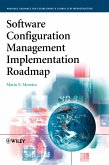Andreas Knöpfel, Bernhard Gröne, Peter Tabeling
Fundamental Modeling Concepts
Effective Communication of It Systems
Andreas Knöpfel, Bernhard Gröne, Peter Tabeling
Fundamental Modeling Concepts
Effective Communication of It Systems
- Broschiertes Buch
- Merkliste
- Auf die Merkliste
- Bewerten Bewerten
- Teilen
- Produkt teilen
- Produkterinnerung
- Produkterinnerung
A must have book for systems analysts, architects and managers interested in enhancing successful communication in their organisation. Provides detailed examples of how to understand and implement fundamental modeling concepts for IT systems communication Provides an already successfully implemented model that has been used at: Siemens, Alcatel, SAP and others Benefits from extensive theoretical and practical research Provides guidelines on how fundamental modeling concepts can be used to support UML, OO, MDA and Architectural Patterns
Andere Kunden interessierten sich auch für
![Managing the Human Factor in Information Security- How to win over staff and influence businessmanagers Managing the Human Factor in Information Security- How to win over staff and influence businessmanagers]() David LaceyManaging the Human Factor in Information Security- How to win over staff and influence businessmanagers37,99 €
David LaceyManaging the Human Factor in Information Security- How to win over staff and influence businessmanagers37,99 €![Computer Security Computer Security]() Dieter GollmannComputer Security64,99 €
Dieter GollmannComputer Security64,99 €![Human-Computer Systems Human-Computer Systems]() Eldo C. KoenigHuman-Computer Systems90,99 €
Eldo C. KoenigHuman-Computer Systems90,99 €![Computers and People Computers and People]() W. Neville HolmesComputers and People81,99 €
W. Neville HolmesComputers and People81,99 €![Wiley Encyclopedia of Computer Science and Engineering, 5 Volume Set Wiley Encyclopedia of Computer Science and Engineering, 5 Volume Set]() Wiley Encyclopedia of Computer Science and Engineering, 5 Volume Set2.284,99 €
Wiley Encyclopedia of Computer Science and Engineering, 5 Volume Set2.284,99 €![Spectral Logic and Its Applications for the Design of Digital Devices Spectral Logic and Its Applications for the Design of Digital Devices]() Mark G. KarpovskySpectral Logic and Its Applications for the Design of Digital Devices205,99 €
Mark G. KarpovskySpectral Logic and Its Applications for the Design of Digital Devices205,99 €![Software Configuration Management Implementation Roadmap Software Configuration Management Implementation Roadmap]() Mario E. MoreiraSoftware Configuration Management Implementation Roadmap106,99 €
Mario E. MoreiraSoftware Configuration Management Implementation Roadmap106,99 €-
-
-
A must have book for systems analysts, architects and managers interested in enhancing successful communication in their organisation. Provides detailed examples of how to understand and implement fundamental modeling concepts for IT systems communication Provides an already successfully implemented model that has been used at: Siemens, Alcatel, SAP and others Benefits from extensive theoretical and practical research Provides guidelines on how fundamental modeling concepts can be used to support UML, OO, MDA and Architectural Patterns
Produktdetails
- Produktdetails
- Verlag: Wiley & Sons
- 1. Auflage
- Seitenzahl: 352
- Erscheinungstermin: 1. Mai 2006
- Englisch
- Abmessung: 235mm x 191mm x 19mm
- Gewicht: 620g
- ISBN-13: 9780470027103
- ISBN-10: 047002710X
- Artikelnr.: 20870041
- Herstellerkennzeichnung
- Libri GmbH
- Europaallee 1
- 36244 Bad Hersfeld
- gpsr@libri.de
- Verlag: Wiley & Sons
- 1. Auflage
- Seitenzahl: 352
- Erscheinungstermin: 1. Mai 2006
- Englisch
- Abmessung: 235mm x 191mm x 19mm
- Gewicht: 620g
- ISBN-13: 9780470027103
- ISBN-10: 047002710X
- Artikelnr.: 20870041
- Herstellerkennzeichnung
- Libri GmbH
- Europaallee 1
- 36244 Bad Hersfeld
- gpsr@libri.de
Dr. Andreas Knöpfel is an FMC expert and learnt much about its practical value during his four years at SAP. He now works as a system analyst and requirements engineer. Dr. Bernhard Gröne worked at SAP for 5 years as system analyst and architect. Following that, he completed his PhD at the Hasso-Plattner-Institute at the University of Potsdam. His research topics are analyzing and modeling complex systems and patterns. Dr. Peter Tabeling has several years of industrial and academic experience in the modeling of complex systems, among them SAP's R/3 system. He is currently Assistant Professor at the Hasso-Plattner-Institute at the University of Potsdam, where he researches and gives lectures on FMC and other topics.
Foreword.
Preface.
1 Introduction.
1.1 The need for communication.
1.2 The FMC Idea.
1.3 Outline of this book.
2 Compositional Structures.
2.1 An example: The travel agency.
2.2 Modeling the structure of a system.
2.3 Agents accessing storages.
2.4 Agents communicate via channels.
2.5 Summary.
2.6 Exercises.
3 Dynamic Structures.
3.1 Petrinets: Basic principles.
3.2 Conflicts and conditions.
3.3 Basic patterns.
3.4 Responsibilities and scope boundaries.
3.5 Summary.
3.6 Exercises.
4 Value Structures and Mind Maps.
4.1 Entity sets and relationships.
4.2 Cardinalities.
4.3 Predicates and roles.
4.4 Partitions.
4.5 Reification.
4.6 Summary.
4.7 Exercises.
5 FMC Basics: Summary.
6 Reinforcing the Concepts.
6.1 The meta model: A mind map to FMC.
6.2 Operational versus control state.
6.3 Block diagrams: Advanced concepts.
6.4 Petrinets: Advanced concepts.
6.5 Non-hierarchical transformations and semantic layers.
6.6 Exercises.
7 Towards Implementation Structures.
7.1 System structure versus software structure.
7.2 From Processor to processes.
7.3 Distribution, concurrency and synchronization.
7.4 From FMC to objects and classes.
7.5 Conceptual patterns versus software patterns.
8 Applying FMC in Your Daily Work.
8.1 Becoming comfortable with FMC.
8.2 Describing existing systems with FMC.
8.3 Using FMC in construction.
8.4 Using FMCdiagrams to support communication.
8.5 Guidelines for didactical modeling.
8.6 Cost and benefit of modeling.
9 Modeling and Visualization Guidelines.
9.1 Introduction.
9.2 Increasingt he reader's perception.
9.3 Increasing comprehension.
9.4 Secondary notation, patterns and pitfalls.
10 Relationship with Other Modeling Approaches.
10.1 Comparing FMC with Structured Analysis.
10.2 FMC and the Unified Modeling Language.
11 A System of Server Patterns 247
11.1 Applicationdomain.
11.2 A pattern language for request processing servers.
11.3 Example applications.
11.4 Conclusion and further research.
Epilogue.
A Solutions.
B Reference Sheets.
C Glossary.
References.
Index.
Preface.
1 Introduction.
1.1 The need for communication.
1.2 The FMC Idea.
1.3 Outline of this book.
2 Compositional Structures.
2.1 An example: The travel agency.
2.2 Modeling the structure of a system.
2.3 Agents accessing storages.
2.4 Agents communicate via channels.
2.5 Summary.
2.6 Exercises.
3 Dynamic Structures.
3.1 Petrinets: Basic principles.
3.2 Conflicts and conditions.
3.3 Basic patterns.
3.4 Responsibilities and scope boundaries.
3.5 Summary.
3.6 Exercises.
4 Value Structures and Mind Maps.
4.1 Entity sets and relationships.
4.2 Cardinalities.
4.3 Predicates and roles.
4.4 Partitions.
4.5 Reification.
4.6 Summary.
4.7 Exercises.
5 FMC Basics: Summary.
6 Reinforcing the Concepts.
6.1 The meta model: A mind map to FMC.
6.2 Operational versus control state.
6.3 Block diagrams: Advanced concepts.
6.4 Petrinets: Advanced concepts.
6.5 Non-hierarchical transformations and semantic layers.
6.6 Exercises.
7 Towards Implementation Structures.
7.1 System structure versus software structure.
7.2 From Processor to processes.
7.3 Distribution, concurrency and synchronization.
7.4 From FMC to objects and classes.
7.5 Conceptual patterns versus software patterns.
8 Applying FMC in Your Daily Work.
8.1 Becoming comfortable with FMC.
8.2 Describing existing systems with FMC.
8.3 Using FMC in construction.
8.4 Using FMCdiagrams to support communication.
8.5 Guidelines for didactical modeling.
8.6 Cost and benefit of modeling.
9 Modeling and Visualization Guidelines.
9.1 Introduction.
9.2 Increasingt he reader's perception.
9.3 Increasing comprehension.
9.4 Secondary notation, patterns and pitfalls.
10 Relationship with Other Modeling Approaches.
10.1 Comparing FMC with Structured Analysis.
10.2 FMC and the Unified Modeling Language.
11 A System of Server Patterns 247
11.1 Applicationdomain.
11.2 A pattern language for request processing servers.
11.3 Example applications.
11.4 Conclusion and further research.
Epilogue.
A Solutions.
B Reference Sheets.
C Glossary.
References.
Index.
Foreword.
Preface.
1 Introduction.
1.1 The need for communication.
1.2 The FMC Idea.
1.3 Outline of this book.
2 Compositional Structures.
2.1 An example: The travel agency.
2.2 Modeling the structure of a system.
2.3 Agents accessing storages.
2.4 Agents communicate via channels.
2.5 Summary.
2.6 Exercises.
3 Dynamic Structures.
3.1 Petrinets: Basic principles.
3.2 Conflicts and conditions.
3.3 Basic patterns.
3.4 Responsibilities and scope boundaries.
3.5 Summary.
3.6 Exercises.
4 Value Structures and Mind Maps.
4.1 Entity sets and relationships.
4.2 Cardinalities.
4.3 Predicates and roles.
4.4 Partitions.
4.5 Reification.
4.6 Summary.
4.7 Exercises.
5 FMC Basics: Summary.
6 Reinforcing the Concepts.
6.1 The meta model: A mind map to FMC.
6.2 Operational versus control state.
6.3 Block diagrams: Advanced concepts.
6.4 Petrinets: Advanced concepts.
6.5 Non-hierarchical transformations and semantic layers.
6.6 Exercises.
7 Towards Implementation Structures.
7.1 System structure versus software structure.
7.2 From Processor to processes.
7.3 Distribution, concurrency and synchronization.
7.4 From FMC to objects and classes.
7.5 Conceptual patterns versus software patterns.
8 Applying FMC in Your Daily Work.
8.1 Becoming comfortable with FMC.
8.2 Describing existing systems with FMC.
8.3 Using FMC in construction.
8.4 Using FMCdiagrams to support communication.
8.5 Guidelines for didactical modeling.
8.6 Cost and benefit of modeling.
9 Modeling and Visualization Guidelines.
9.1 Introduction.
9.2 Increasingt he reader's perception.
9.3 Increasing comprehension.
9.4 Secondary notation, patterns and pitfalls.
10 Relationship with Other Modeling Approaches.
10.1 Comparing FMC with Structured Analysis.
10.2 FMC and the Unified Modeling Language.
11 A System of Server Patterns 247
11.1 Applicationdomain.
11.2 A pattern language for request processing servers.
11.3 Example applications.
11.4 Conclusion and further research.
Epilogue.
A Solutions.
B Reference Sheets.
C Glossary.
References.
Index.
Preface.
1 Introduction.
1.1 The need for communication.
1.2 The FMC Idea.
1.3 Outline of this book.
2 Compositional Structures.
2.1 An example: The travel agency.
2.2 Modeling the structure of a system.
2.3 Agents accessing storages.
2.4 Agents communicate via channels.
2.5 Summary.
2.6 Exercises.
3 Dynamic Structures.
3.1 Petrinets: Basic principles.
3.2 Conflicts and conditions.
3.3 Basic patterns.
3.4 Responsibilities and scope boundaries.
3.5 Summary.
3.6 Exercises.
4 Value Structures and Mind Maps.
4.1 Entity sets and relationships.
4.2 Cardinalities.
4.3 Predicates and roles.
4.4 Partitions.
4.5 Reification.
4.6 Summary.
4.7 Exercises.
5 FMC Basics: Summary.
6 Reinforcing the Concepts.
6.1 The meta model: A mind map to FMC.
6.2 Operational versus control state.
6.3 Block diagrams: Advanced concepts.
6.4 Petrinets: Advanced concepts.
6.5 Non-hierarchical transformations and semantic layers.
6.6 Exercises.
7 Towards Implementation Structures.
7.1 System structure versus software structure.
7.2 From Processor to processes.
7.3 Distribution, concurrency and synchronization.
7.4 From FMC to objects and classes.
7.5 Conceptual patterns versus software patterns.
8 Applying FMC in Your Daily Work.
8.1 Becoming comfortable with FMC.
8.2 Describing existing systems with FMC.
8.3 Using FMC in construction.
8.4 Using FMCdiagrams to support communication.
8.5 Guidelines for didactical modeling.
8.6 Cost and benefit of modeling.
9 Modeling and Visualization Guidelines.
9.1 Introduction.
9.2 Increasingt he reader's perception.
9.3 Increasing comprehension.
9.4 Secondary notation, patterns and pitfalls.
10 Relationship with Other Modeling Approaches.
10.1 Comparing FMC with Structured Analysis.
10.2 FMC and the Unified Modeling Language.
11 A System of Server Patterns 247
11.1 Applicationdomain.
11.2 A pattern language for request processing servers.
11.3 Example applications.
11.4 Conclusion and further research.
Epilogue.
A Solutions.
B Reference Sheets.
C Glossary.
References.
Index.









